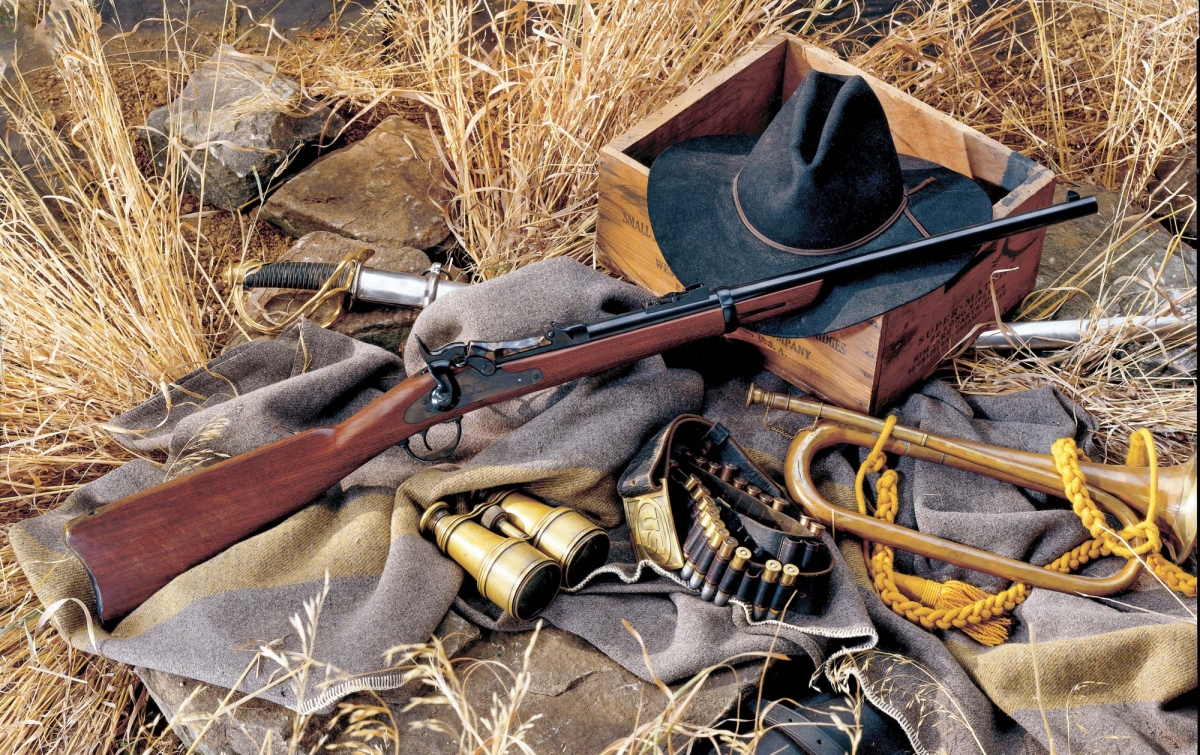Springfield 1873 “Trapdoor”
1873-2023: 150 years ago, the 1873 Springfield "Trapdoor" in .45-70 Government was one of the first successful military breech-loading rifles
The civil war years, and in particular those following the battle of Gettysburg, gave to the United States military organs more than one good reason to analyze with great attention the advantages offered by the many breechloading systems adopted for the single shot and repeating firearms of the time. In 1865 the end of the war had left tens of thousands muzzleloading guns in the national arsenals, whose value couldn't be neglected, especially in consideration of the natural economic recession that the country soon had to face.
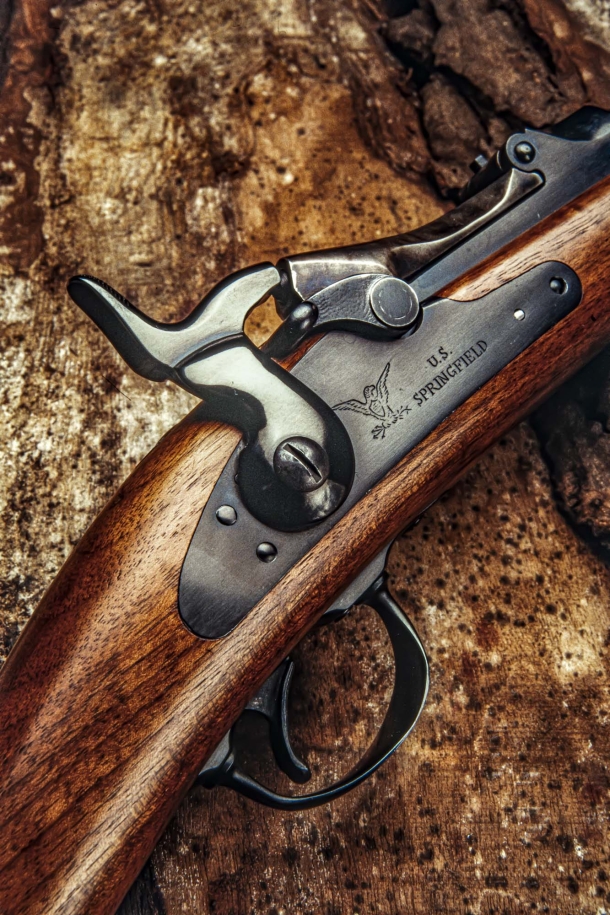
In this particular historic and military context, the Ordnance Board matured its project for the conversion of the many existing muskets to an efficient and economically practicable breechloading system; project that in 1865 saw its concrete realization through the well-known patent of Erskine S. Allin, Master Armorer of the Springfield Armory, worked to the modification of the existing patterns 1861 and 1863 to come to the first versions of the famous Springfield 'Trapdoor'.
In the passage to the new breechloading system the old muzzleloading guns so transformed still maintained the original .58 caliber, yet with the adoption of a metallic rimfire cartridge, whose performances soon become object of adverse criticism; not later than 1866 some improvements were introduced, the most part concerning the structure of the ejector and the percussor, at the same time passing to a new center fire cartridge in .50 caliber - the .50-70 Government - utilizing a lighter bullet (450 grains instead of 500) pushed by a stronger 70 grains black powder charge (instead of 60 grains).
The new ammunition gave interesting performances, but the whole characteristics of the gun, which in 1868 underwent further retouches, still remained substantially the same: till that moment the official organs had accepted Allin modification only as a transitional expedient, a way to 'recycle' the many rifles, and rifles parts, still available at Springfield.
In prevision of the adoption of a completely new breechloading rifle, perhaps a repeater, between 1870 and 1872 the Ordnance Board started a series of important experimental tests: the guns taken into consideration, some fifty different models, besides those proposed by Remington, Sharps, Winchester and naturally Springfield, included prototypes coming from all over the world.
The American economic difficulties of 1873, the still unstable objectives of the internal politics, together with the inevitable dull ostracism of the most conservative military factions, and maybe even some 'bribes', all contributed to the final decision which sprang from the just concluded government tests: in spite of the interest raised by the single shot Remington Rolling Block and the innovative eight shots Ward-Burton bolt action rifle, opportunely revised the Springfield Trapdoor would have become the ordinance arm for both the infantry and the cavalry. The evaluations concerning lower production costs and higher strength and reliability of the single shot arm closed the discussion once and for all.

The Springfield "Trapdoor" 1873, in the two versions: infantry rifle and cavalry carbine (modern Pedersoli reproductions)
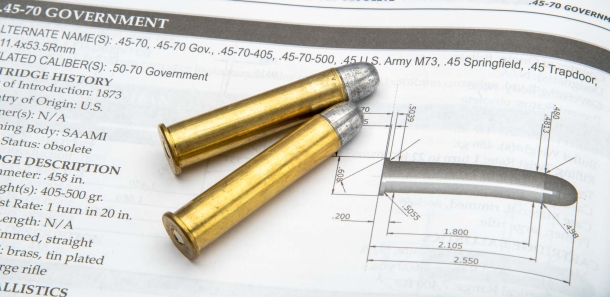
The .45-70 Government cartridge, still in use today
The revision and standardization of the official ammunition represented as well an important assumption of the entire project. This gave birth to the .45-70Government cartridge, still very popular today, and the newly adopted rifle and carbine versions of the 1873 Springfield Trapdoor were thus chambered for this caliber.
Fundamentally the .45-70 replaced the .50-70 for two main reasons: since 1860 careful studies carried out in England on muzzleloading rifles had fully demonstrated the ballistic advantages of .45 caliber guns using rapid twists and heavy elongated bullets of about 450-500 grains in weight; furthermore, although the difference was minimal, an equal number of cartridges being considered (40 cartridges, the standard dotation), the .45-70 cartridge weighed less than those in .50-70.
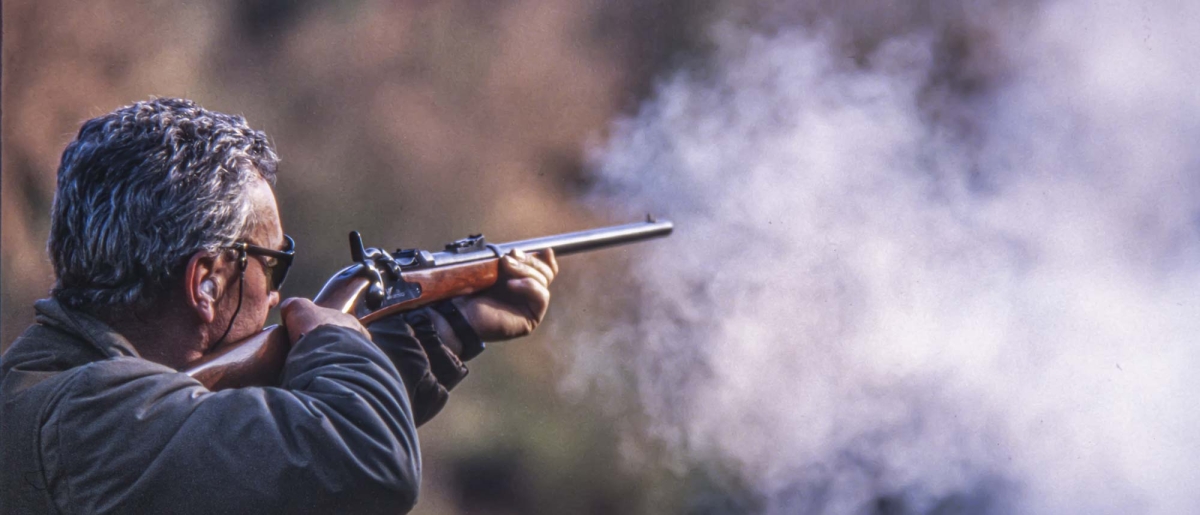
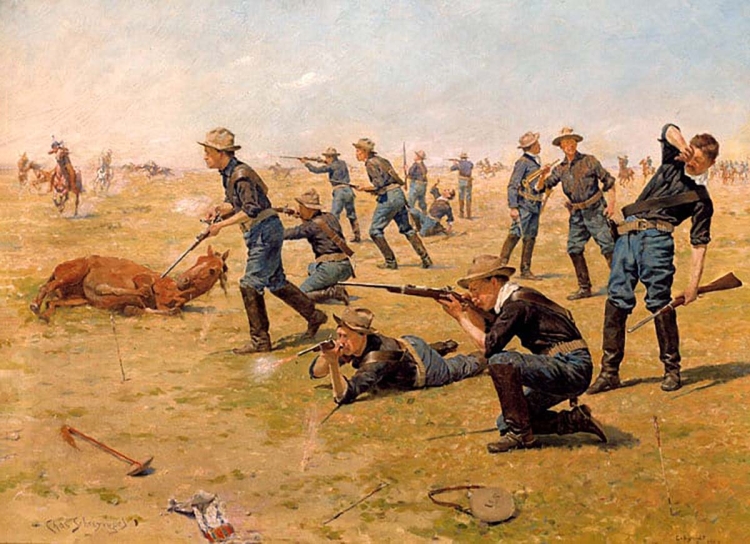
On the Skirmish Line (Charles Schreyvogel - 1900)
For nearly twenty years, the Springfield Trapdoor carbine was the standard issue rifle for cavalry troops during the height of the Indian Wars.
From 1865 to 1898 the U.S. Army faced about 943 fights with the Indians, the most part of them sustained by cavalry units. A sort of leading character during one of the most dramatic moments in American history, throughout the Indian wars the military efficiency of the Springfield Trapdoor was anything but undisputed, with particular regard to the extractor reliability, especially after Custer's failure on the Little Big Horn in 1876.
Taken in the whole context the gun had anyhow an important role, and the affection which thousands of historic guns enthusiasts, not only in the United Statest, still demonstrate to this single-shot had fully justified the Italian firm Davide Pedersoli in its decision to introduce (many years ago) a modern faithful reproduction of the 'Trapdoor', or better, two reproductions, all chambered for the everlasting .45-70 Government: the cavalry carbine model, probably the most popular version and object of our illustrations, and the long infantry rifle, each of which is also available in some variants..
The fore portion of the receiver, were the extractor is located, is screwed to the round tapered barrel. To the rear of the receiver we find the breech screw, with the tang through which the whole breech assembly is secured to the head of the stock.


When in horizontal position the Pedersoli carbine rear sight allows settings up to 400 yards, and up to 1200 yards when the leaf is raised vertically. Lacking any kind of lateral protection, as on the originals the carbine steel front sight is mounted on a stud.
Even in the case of the beautiful Pedersoli Trapdoor, the usual consideration common to the vast majority of replicas of historical weapons applies: the rear sight and front sight follow the originals, so, small as they are, a clear alignment is obtained only in backlight conditions.
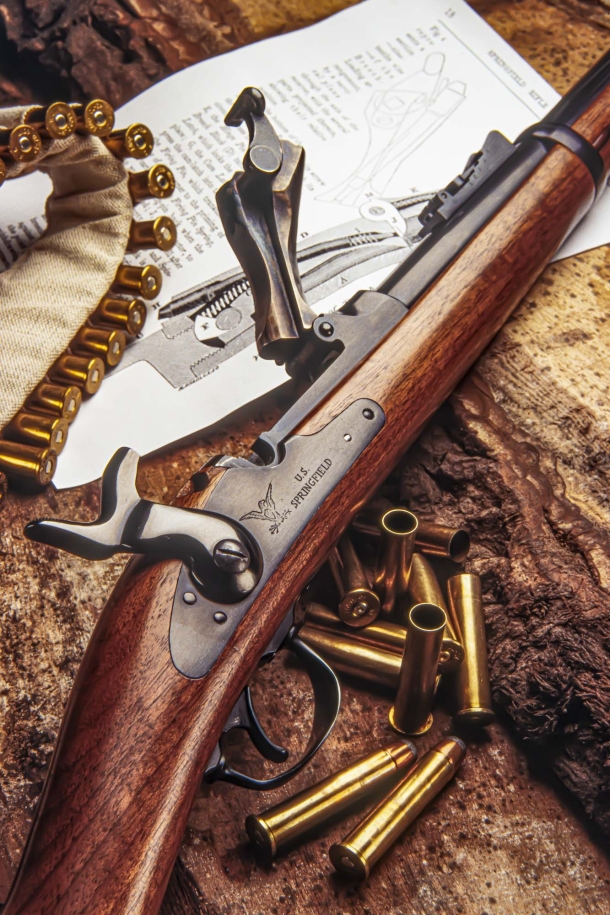
Springfield 1873 “Trapdoor”
The mechanical plan of the lock is the traditional Springfield, the main spring pointing forward, with three cocking positions for the hammer: the safety, the half-cock and the full-cock. The action is smooth, with the main spring connected to the tumbler by a swivel. All the metallic components are blued, except for the breech block which is case-hardened.
The 'trap-door', the breech-block, is the real heart of the Springfield 1873. The breech is hinged to the front-upper section of the receiver in a way that allows it to pivot forward, discovering the receiver; the breech-block contains the firing pin and the cam-latch which locks it shut. Pushed by a little, but strong spring the extractor in the receiver hit with force the head of the shell throwing it backward, against the ejector stud and out of the receiver.
The malfunction of the extractor system became a recurring problem for this gun, although usually related to particular conditions of intense shooting: it is to be considered that until 1885 the .45-70-405 cartridges prepared at the Frankford Arsenal (the U.S. Army supplier) utilized copper cases, whose soft metal often risked to stick to the cartridge chamber walls when the gun overheated beyond a certain limit.
In the worst event, under the extractor action this could cause partial damaging or complete separation of the fragile shell's head. A critic eventuality that doesn't characterize the modern Pedersoli replica both for the different technologies applied to the metallic shells production of today and, fortunately, for the absence of contingent necessities which could force us to live again experiences as the Custer's one on the Little Big Horn.


In 1892 the Krag-Jorgensen, finally a repeater, officially substituted the Springfield 1873 as ordnance weapon of the United States military forces, though in reality the old 'Allin Gun' would have seen active service for some more years. With the Krag-Jorgensen times were changing, and with it the needs of a country that after thirty years of Indian wars now had to try its military strength with those of other countries.
The 'Trapdoor' gained its place in the history of individual armaments: at first as a much sought after trophy of collectors of original arms, today as a sporting iron or argument of study available to everyone, thanks to the modern Pedersoli replicas.




